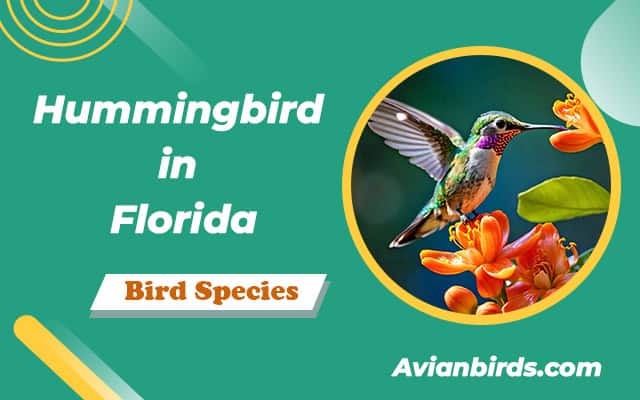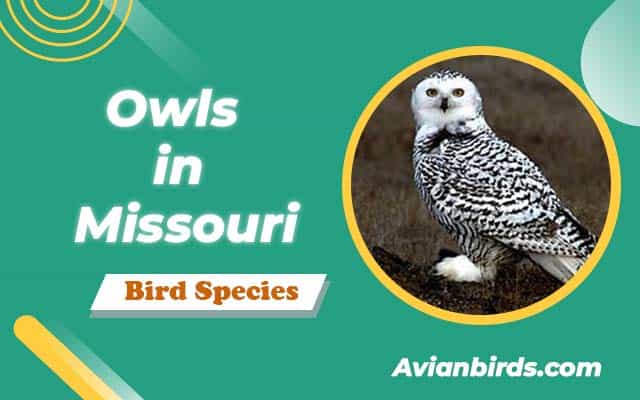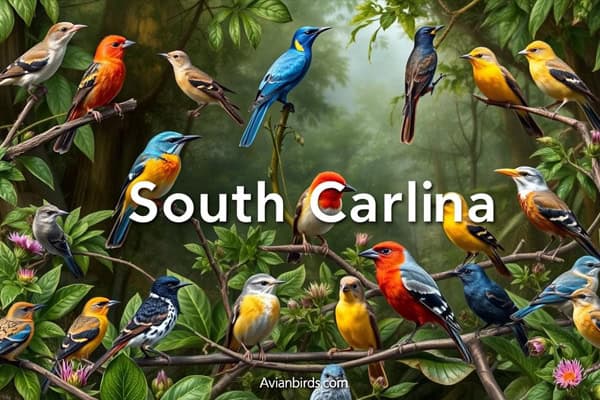8 Hummingbird Species in Florida (With Pictures)
When you think of hummingbirds, the image of a Ruby-throated hummingbird, a species of hummingbird commonly found in Florida, often may stay in South Florida during winter. may come to mind. But did you know that Florida is a hotspot for hummingbird diversity? With an astounding eight different species, including the iconic Ruby-throated hummingbird and the elusive Rufous hummingbird, the Sunshine State is a paradise for hummingbird enthusiasts.
In this article, we will delve into the fascinating world of hummingbirds in Florida. From tips on attracting these tiny jewels to your yard to exploring the unique traits and habitats of lesser-known species, get ready to be captivated by the incredible diversity of hummingbirds in the beautiful state of Florida.
Here we’ll learn about 8 different types of Hummingbirds in Florida
1. Ruby-throated Hummingbird in Florida
- Scientific name: (Archilochus colubris)
- Life span: 3-5 years
- Size: 7 to 9 cm
- Weight: 2 to 6 g
- Wingspan: 8 to 11 cm
- Status: Least concern
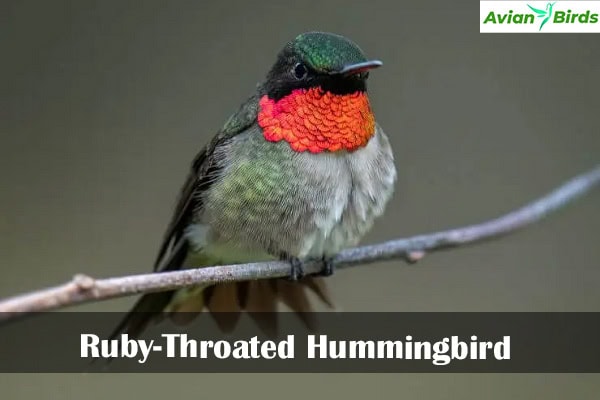
The Ruby-throated hummingbird is a captivating and frequently observed species in Florida. Known for its vibrant colors and remarkable agility, attracting these lovely birds to your yard can bring joy and wonder to your daily life. To create an enchanting habitat for Ruby-throated hummingbirds, follow these simple yet effective tips.
Setting up a Hummingbird Feeder
A hummingbird feeder is an essential element for attracting these tiny birds. Place it in a visible and easily accessible location, away from direct sunlight to prevent nectar spoilage, ensuring energy for non-ruby-throated hummingbird sightings as well. nectar spoilage. Make sure to clean the feeder regularly to maintain hygiene. It’s best to hang the feeder at a convenient height, allowing you to enjoy a closer view of their charming antics.
Providing the Right Nectar
Hummingbirds thrive on nectar, so it’s crucial to provide them with a suitable and nutritious food source. Prepare a simple solution of four parts water and one part white granulated sugar. Remember to boil the water to remove any impurities before dissolving the sugar. Allow the nectar to cool completely before filling the feeder. Never use artificial sweeteners, honey, or red dye, as they can be harmful to hummingbirds.
“Setting up a hummingbird feeder and offering the right nectar can turn your backyard into a hummingbird haven.” – Jane Peterson, Hummingbird Enthusiast
Cultivating Hummingbird-Friendly Plants
Another effective way to attract Ruby-throated hummingbirds is by planting nectar-rich flowers and plants in your yard. Opt for native flowering species such as coral honeysuckle, fire bush, bee balm, and salvias, all known to attract hummingbirds of Florida. These vibrant blooms not only provide a natural food source but also create a beautiful and colorful landscape that will captivate both hummingbirds and humans alike.
To further entice these delightful birds, incorporate a variety of plant heights, colors, and textures. This diversity will attract a wider range of insect species, making your garden an irresistible haven for Ruby-throated hummingbirds.
Observing and Documenting
Take the time to observe the Ruby-throated hummingbirds as they visit your feeder and flowers. Keep a journal or take photographs to document their arrival and behaviors. By tracking their patterns and preferences, you can make adjustments to your feeder and plant choices to provide an optimal environment for these majestic creatures.
| Species found in Florida not only include the Ruby-throated but also other non-ruby-throated hummingbird sightings have been recorded. | Scientific Name | Habitat |
|---|---|---|
| Ruby-throated hummingbird | Archilochus colubris | Woodlands, gardens, meadows |
| Rufous Hummingbird | Selasphorus rufus | Forests, mountain meadows |
2. Rufous Hummingbird
- Scientific name: (Selasphorus rufus)
- Life span: 3-5 years
- Size: 8 cm (3.1 in)
- Weight: 2–5 g (0.071–0.176 oz)
- Wingspan: 11 cm (4.3 in)
- Status: Near Threatened
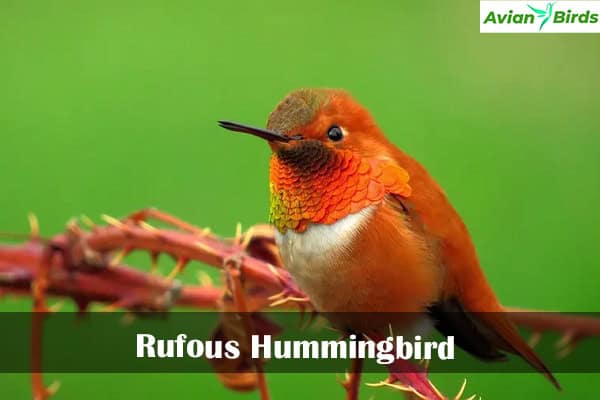
The Rufous hummingbird is a rare sight in Florida but can occasionally be spotted during migration. This stunning species is known for its vibrant orange-red feathers and its unique humming sound that distinguishes it from other hummingbirds.
If you’re lucky enough to catch a glimpse of a Rufous hummingbird, it’s truly a treat. These small but powerful birds are known for their agility and speed, making them a delight to watch as they dart around in search of nectar.
To increase your chances of attracting Rufous hummingbirds to your yard, consider setting up hummingbird feeders. These feeders provide a reliable source of nectar, which is essential for their survival and energy needs during their long migration journeys.
Tips for Attracting Rufous Hummingbirds
Here are some tips to help you create an inviting environment for Rufous hummingbirds:
- Choose a feeder with bright, eye-catching colors to grab their attention.
- Hang the feeder in a shaded area to protect the nectar from spoiling in the hot Florida sun, a recommendation supported by the University of Florida.
- Keep the feeder clean and refill it regularly to ensure a fresh supply of nectar.
- Plant native flowers and shrubs that produce nectar-rich blooms, such as trumpet vines, salvias, and bee balm.
- Provide a water source, such as a shallow birdbath or misting feature, for the hummingbirds to drink and bathe.
By following these tips and creating a welcoming space with hummingbird feeders and native plants, you can increase your chances of attracting a Rufous hummingbird to your yard.
| Rufous Hummingbird | Description of various hummingbird species found in Florida can enhance understanding of their needs. |
|---|---|
| Scientific Name | Selasphorus rufus |
| Size | 3 to 3.5 inches (7.6 to 8.9 cm) |
| Weight | 0.1 to 0.2 ounces (2.8 to 5.7 grams) |
| Feathers | Vibrant orange-red on the back and sides, white on the belly |
| Migration | Rufous hummingbirds undertake one of the longest migratory journeys of any hummingbird species, traveling from their summer breeding grounds in the Pacific Northwest to their wintering grounds in Mexico. |
Other Fascinating Hummingbird Species in Florida
While the Ruby-throated and Rufous hummingbirds may be the most well-known, Florida is also home to several other hummingbird species, as noted by the University of Florida. Each of these species possesses unique traits and habitats that make them a delight to observe.
3. Calliope Hummingbird
- Scientific name: (Selasphorus calliope)
- Life span: 5-7 years
- Size: 7 to 10 cm
- Weight: 2 to 3 g
- Wingspan: 8-11 cm
- Status: Least concern

The Calliope hummingbird is the smallest bird native to North America and is known for its iridescent green plumage and distinctive throat markings. These tiny birds can be found in wooded habitats and are often spotted during their migration through Florida.
4. Black-chinned Hummingbird
- Scientific name: (Archilochus alexandri)
- Life span: 3-5 years
- Size: 8.9-9.4 cm
- Weight: 2.5-4 grams
- Wingspan: 11-12 cm
- Status: Least Concern
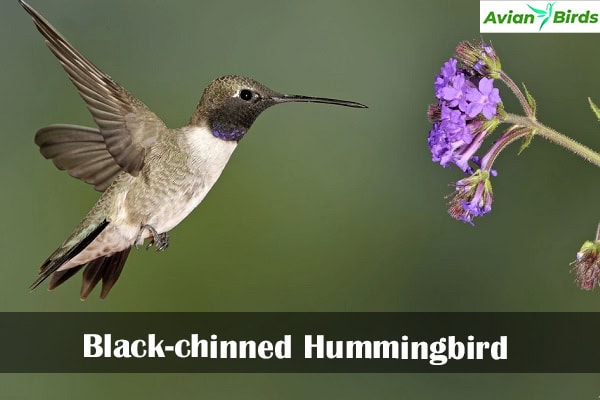
The Black-chinned hummingbird is a stunning species with a black chin and a vibrant purple collar. They prefer open woodlands, gardens, and mountainous areas. Keep an eye out for their graceful flights and exquisite feeding displays.
5. Allen’s Hummingbird
- Scientific name: Selasphorus sasin
- Life span: 5-6 years
- Size: 7.6-9.4 cm
- Weight: 2.5-3.6 grams
- Wingspan: 11-12 cm
- Status: Least Concern
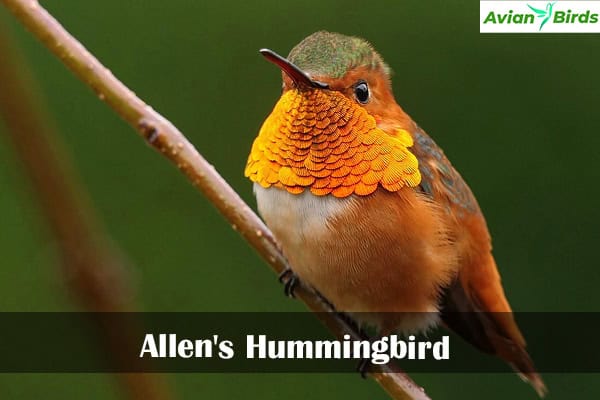
The Allen’s hummingbird is known for its vibrant orange-red throat and emerald-green body. These hummingbirds can be spotted in coastal areas, chaparral, and desert regions of Florida. Look for their elaborate courtship flights during the breeding season.
6. Broad-tailed Hummingbird
- Scientific name: Selasphorus platycercus
- Life span: 5-6 years
- Size: 9-10 cm
- Weight: 2.5-4 grams
- Wingspan: 12 cm
- Status: Least Concern
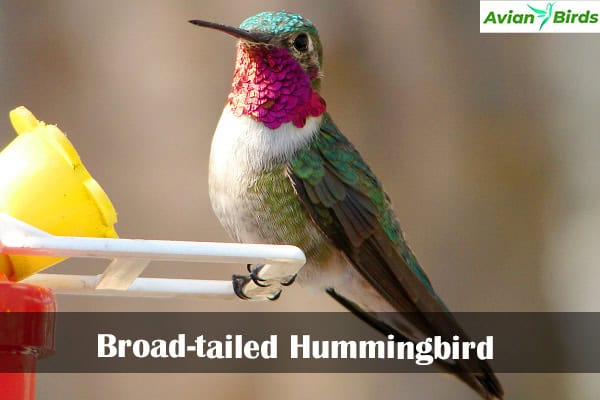
The Broad-tailed hummingbird boasts a shimmering emerald green plumage and a distinct metallic chirping sound. They can be found in open montane forests and meadows. Keep an eye out for their energetic flights and characteristic high-pitched calls.
7. Broad-billed Hummingbird
- Scientific name: Cynanthus latirostris
- Life span: 5-6 years
- Size: 9-11 cm
- Weight: 3-5 grams
- Wingspan: 12 cm
- Status: Least Concern
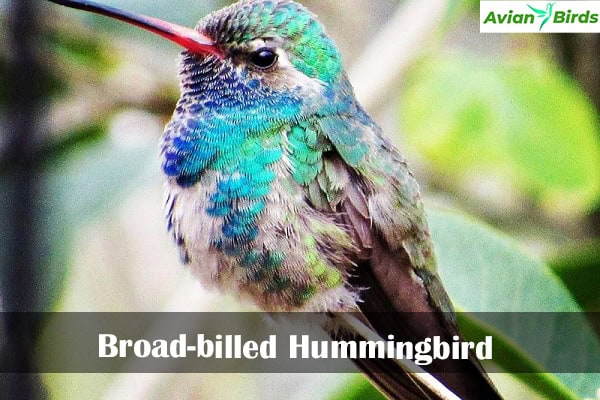
The Broad-billed hummingbird features a striking iridescent blue throat and a long, straight bill. They primarily inhabit desert areas and can be seen visiting gardens with nectar-rich flowers. Don’t miss their dazzling aerial acrobatics.
8. Buff-bellied Hummingbird
- Scientific name: Amazilia yucatanensis
- Life span: 5-6 years
- Size: 9-10 cm
- Weight: 3-5 grams
- Wingspan: 12 cm
- Status: Least Concern

The Buff-bellied hummingbird is a beautiful species with a cinnamon-colored belly and green back feathers. They frequent the coastal regions of Florida and are often seen feeding on nectar from flowering plants. Don’t forget to listen for their distinctive buzzing calls.
Exploring the diverse hummingbird species in Florida allows you to appreciate the sheer beauty and variety these tiny birds bring to the state’s ecosystems. Whether you spot the delicate Calliope hummingbird, the elegant Black-chinned hummingbird, or any of the other fascinating species, take a moment to marvel at their incredible adaptations and the natural wonders that surround us.
Attracting Hummingbirds to Your Florida Yard
Creating a hummingbird-friendly environment in your Florida yard is a rewarding experience that will bring these delightful creatures right to your doorstep. By planting species of hummingbird-attracting flowers, you can encourage more hummingbird sightings in your garden. native plants that provide nectar and understanding hummingbird migration patterns, you can attract these incredible birds and create a welcoming space for them.
One of the key factors in attracting hummingbirds is planting native plants. Native plants not only provide a natural habitat for these birds but also offer a rich source of nectar. Consider incorporating plants such as Coral Honeysuckle, Firebush, and Bee Balm into your yard. These flowering plants are excellent hummingbird plants that provide the nectar these birds need to fuel their energy, essential for both local species and those passing through central Florida.
In addition to planting native plants, it’s important to provide a variety of nectar sources throughout the year. Hummingbirds have different feeding habits and prefer different types of flowers. By planting a diverse selection of flowers that bloom at different times, you can ensure a continuous supply of nectar for these beautiful creatures, including those visiting from Central Florida.
Hummingbird Migration Patterns
Understanding hummingbird migration patterns is crucial in creating a welcoming space for these birds. The timing of migration can vary depending on the species, with some hummingbirds arriving in Florida as early as January and others passing through in the fall. By knowing when hummingbirds are likely to be in your area, you can plan your garden to provide a ready food source during these periods.
During migration, hummingbirds need to refuel frequently to sustain their long flights, especially those crossing South Florida. By offering a reliable source of nectar through your carefully chosen native plants, you can attract these weary travelers and provide them with the energy they need to continue their journey, including nesting opportunities in Central Florida.
“Creating a hummingbird-friendly environment in your Florida yard is not only beneficial for the birds, but it also allows you to witness their incredible beauty up close.”
In addition to nectar, hummingbirds also rely on insects as a source of protein. By avoiding the use of pesticides in your yard, you can ensure a healthy environment for both hummingbirds and their insect prey. This will make your yard even more attractive to these amazing birds.
Creating a hummingbird-friendly environment in your Florida yard is not only beneficial for the birds, but it also allows you to witness their incredible beauty up close. By planting native plants that provide nectar and understanding hummingbird migration patterns, you can enjoy the presence of these tiny jewels right in your own backyard.
Check Our Previous Articles:
| Native Plants for Attracting Hummingbirds | Blooming Season |
|---|---|
| Coral Honeysuckle (Lonicera sempervirens) | Spring to fall |
| Firebush (Hamelia patens), a plant native to South Florida, is favored by many types of hummingbirds for its nectar. | Year-round |
| Bee Balm (Monarda spp.), is a flower highly attractive to numerous species of hummingbirds found in Florida. | Spring to summer |
| Red Salvia (Salvia coccinea) | Year-round |
Final Thoughts:
Florida is like a playground for people who love hummingbirds. There are lots of different kinds of hummingbirds there. For example, the bright Ruby-throated hummingbird lives there all year round. Sometimes, the rare Rufous hummingbird pops by when it’s moving from one place to another. There’s always something cool to see.
Firstly, if you make your backyard a nice place for them, you can get these awesome birds to come over. How? Well, you can plant flowers that they like because they have sweet nectar. Also, if you know when they usually fly through your area and what they like to eat, you can make sure they’ll want to hang out in your yard.
Secondly, you don’t have to be super into birds to enjoy watching hummingbirds in Florida. They’re really pretty and fun to watch. So, why not turn your backyard into a little paradise for these cute birds? Get ready for some fun as you watch these little sparkly birds fly around and make your day brighter.

